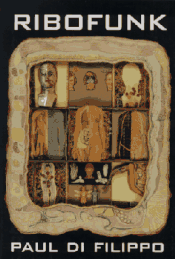(Redirected from Biopunk movement )
Science fiction genre that focuses on technological use of life studies
This article is about dystopian cyberpunk and science fiction subgenre. For real-life citizen science and advocacy movement, see Do-it-yourself biology .
Biopunk (a portmanteau of "biotechnology " or "biology " and "punk ") is a subgenre of science fiction that focuses on biotechnology. It is derived from cyberpunk , but focuses on the implications of biotechnology rather than mechanical cyberware and information technology . Biopunk is concerned with synthetic biology . It is derived from cyberpunk and involve bio-hackers , biotech megacorporations , and oppressive government agencies that manipulate human DNA . Most often keeping with the dark atmosphere of cyberpunk, biopunk generally examines the dark side of genetic engineering and depicts the potential perils of biotechnology .
Description
Cover of Ribofunk by Paul Di Filippo , a seminal biopunk story collection. Biopunk is a subgenre of science fiction closely related to cyberpunk that focuses on the near-future (most often unintended) consequences of the biotechnology revolution following the invention of recombinant DNA . Biopunk stories explore the struggles of individuals or groups, often the product of human experimentation , against a typically dystopian backdrop of totalitarian governments and megacorporations which misuse biotechnologies as means of social control and profiteering . Unlike cyberpunk, it builds not on information technology , but on synthetic biology . Like in postcyberpunk fiction, individuals are usually modified and enhanced not with cyberware , but by genetic manipulation . A common feature of biopunk fiction is the "black clinic", which is a laboratory, clinic, or hospital that performs illegal, unregulated, or ethically dubious biological modification and genetic engineering procedures. Many features of biopunk fiction have their roots in William Gibson 's Neuromancer
One of the prominent writers in this field is Paul Di Filippo , though he called his collection of such stories ribofunk , a blend of "ribosome " and "funk ". Di Filippo suggests that precursors of biopunk fiction include H. G. Wells ' The Island of Doctor Moreau Julian Huxley 's The Tissue-Culture King David H. Keller 's stories, Damon Knight 's Natural State and Other Stories ; Frederik Pohl and Cyril M. Kornbluth 's Gravy Planet T. J. Bass and John Varley ; Greg Bear 's Blood Music Bruce Sterling 's Schismatrix Cordwainer Smith , including his first and most famous Scanners Live in Vain New Jedi Order
See also
References
^ Quinion, Michael (1997). "World Wide Words: Biopunk" . Worldwidewords.org . Retrieved 2007-01-26.
Pulver, David L. (1998). GURPS Bio-Tech Steve Jackson Games . ISBN 978-1-55634-336-0 Paul Taylor (June 2000). "Fleshing Out the Maelstrom: Biopunk and the Violence of Information" . M/C Journal . 3 (3). Journal of Media and Culture. doi :10.5204/mcj.1853 .
Fisher, Jeffrey (1996). "Ribofunk" . Wired . Retrieved 2007-01-26.
^ Di Filippo, Paul (1998). "RIBOFUNK: The Manifesto" . Streettech.com . Retrieved 2011-01-05.
Voices for the Future: Essays on Major Science Fiction Writers , Volume 3. Popular Press, 1983, pp. 53–72
"GURPS Bio-Tech – Bibliography" . Sjgames.com . Retrieved 18 December 2021.
External links
Film genres By style
By theme
By movement
By demographic
By format,
Categories :
Text is available under the Creative Commons Attribution-ShareAlike License. Additional terms may apply.
**DISCLAIMER** We are not affiliated with Wikipedia, and Cloudflare.
The information presented on this site is for general informational purposes only and does not constitute medical advice.
You should always have a personal consultation with a healthcare professional before making changes to your diet, medication, or exercise routine.
AI helps with the correspondence in our chat.
We participate in an affiliate program. If you buy something through a link, we may earn a commission 💕
↑
